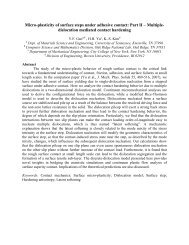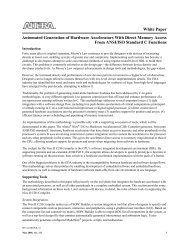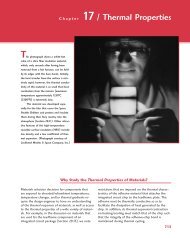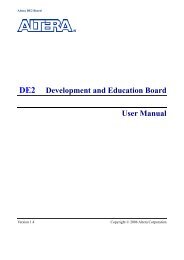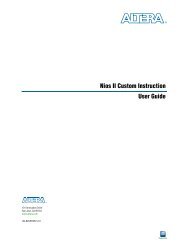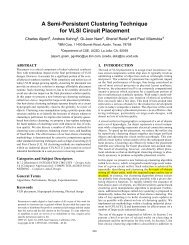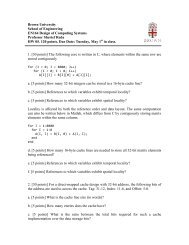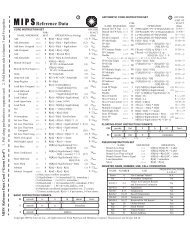HW3 - Brown University
HW3 - Brown University
HW3 - Brown University
You also want an ePaper? Increase the reach of your titles
YUMPU automatically turns print PDFs into web optimized ePapers that Google loves.
<strong>Brown</strong> <strong>University</strong><br />
School of Engineering<br />
EN164 Design of Computing Systems<br />
Professor Sherief Reda<br />
HW 03. 100 points. Due Date: Tuesday, April 10 th in class.<br />
1. [25 points] Assume the following datapath latencies for the individual stages.<br />
IF: 250 ps<br />
ID: 350 ps<br />
EX: 150 ps<br />
MEM: 300 ps<br />
WB: 200 ps<br />
a. [5 points] What is the clock cycle time in a pipelined and non-pipelined<br />
processor?<br />
b. [5 points] What is the total latency of an LW instruction in a pipelined and nonpipelined<br />
processor? Ignore the overhead of the pipeline registers.<br />
c. [5 points] If we can split one stage of the pipelined datapath into two new stages,<br />
each with half the latency of the original stage, which stage would you split and<br />
what is the new clock cycle time of the processor?<br />
Assume that the instructions executed by the processor are broke down as follows:<br />
ALU: 45%<br />
BEQ: 20%<br />
LW: 20%<br />
SW: 15%<br />
d. [5 points] Assume that are no stalls or hazards, what is the utilization of the data<br />
memory?<br />
e. [5 points] Assuming there are no stalls or hazards, what is the utilization of the<br />
write-register port of the register file?<br />
2. [20 points] In this exercise, we examine how the ISA affects pipeline design. Assume<br />
the following new instruction:<br />
ADDM Rd, Rt + Offset(Rs) # $Rd = $Rt + Mem[Offset+$Rs]<br />
a. [5 points] Give an example of where this instruction might be useful and a<br />
sequence of existing MIPS instructions that are placed by this instruction.<br />
b. [5 points] What must be changed in the pipelined datapath to add this instruction<br />
to the MIPS ISA?<br />
c. [5 points] Which new control signals must be added to the pipeline in part (a)?<br />
d. [5 points] Does support for this instruction introduce any new hazards? Are stalls<br />
due to existing hazards made worse?
3. [20 points]<br />
I1: LW R1, 0 (R1)<br />
I2: AND R1, R1, R2<br />
I3: LW R2, 0 (R1)<br />
I4: LW R1, 0 (R3)<br />
a. [5 points] Find all data dependences in this instruction sequence.<br />
b. [5 points] Find all hazards in this instruction sequence for a 5-stage pipeline with<br />
and then without forwarding<br />
c. [10 points] To reduce clock cycle time, we are considering a split of the MEM<br />
stage into two stages, where reading completes in the second MEM stage. Repeat<br />
parts (a) and (b) for this 6-stage pipeline<br />
4. [15 points] The importance of having a good branch predictor depends on how often<br />
conditional branches are executed. Together with branch predictor accuracy, this will<br />
determine how much time is spent stalling due to mispredicted branches. In this exercise,<br />
assume that the breakdown of dynamic instructions into various instruction categories is<br />
as follows:<br />
R-Type: 40% BEQ: 25% JMP: 5% LW: 25% SW: 5%<br />
Also assume the following branch predictor accuracies:<br />
Always-Taken: 45% Always-Not-taken: 55% 2-Bit: 85%<br />
a. [5 points] Stall cycles due to mispredicted branches increase the CPI. What is the<br />
extra CPI due to mispredicted branches with the always-taken predictor? Assume<br />
that branch outcomes are determined in the EX stage, that there are no data<br />
hazards, and that the no delay slot are used.<br />
b. [5 points] Repeat (a) for the “Always-not-taken” predictor.<br />
c. [5 points] Repeat (a) for the 2-bit predictor.<br />
5. [20 points] Assume the following repeating pattern (e.g., in a loop) of branch<br />
outcomes:<br />
T, NT, T, T, NT<br />
a. [5 points] What is the accuracy of always-take and always-not-taken predictors<br />
for this sequence of branch outcomes?<br />
b. [5 points] What is the accuracy of the two-bit predictor for the first four branches<br />
in this pattern, assuming that the predictor starts off in (predict not taken) state<br />
(bottom-left dark-grey state in the lecture slides)?<br />
c. [5 points] What is the accuracy of the two-bit predictor if this pattern is repeated<br />
forever?<br />
d. [5 points] Design a predictor that would achieve a perfect accuracy if this pattern<br />
is repeated forever. Your predictor should be a sequential circuit with one output<br />
that provides a prediction (1 for taken, 0 for not taken) and no inputs other than<br />
the clock and the control signal that indicates that the instruction is a conditional<br />
branch.



